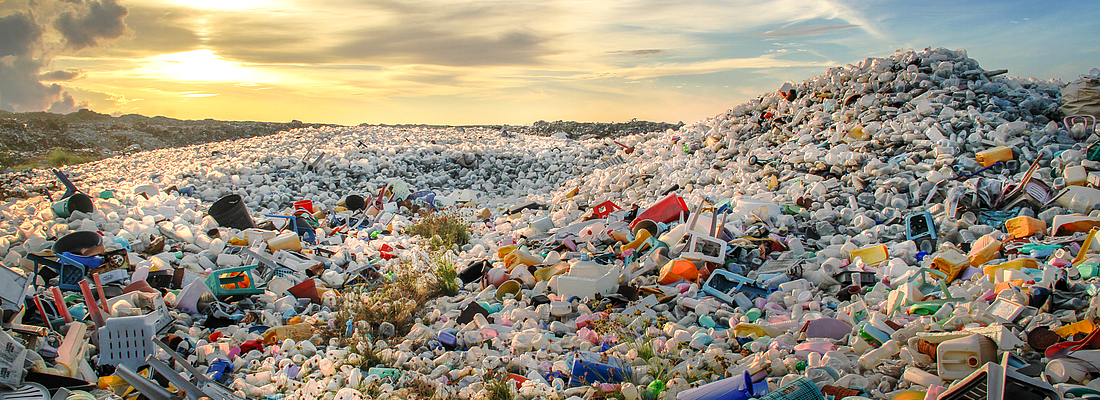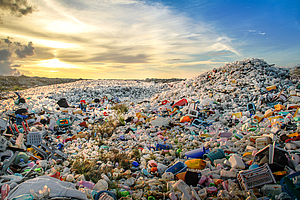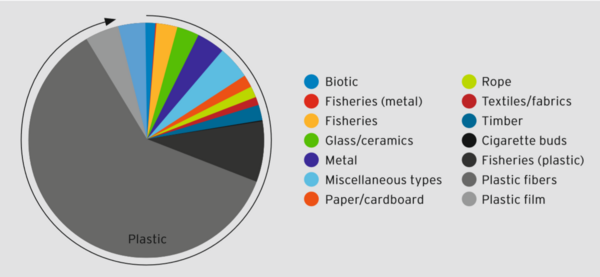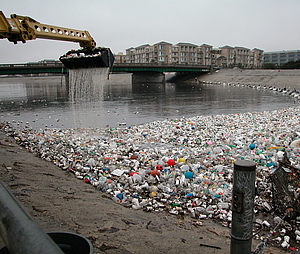The plastics industry has been instrumental in reducing expenses associated with delivering products to consumers. More products have been safely and economically supplied to the consumer than ever before. The industry grew from almost nothing in the early sixties to a $700-billion slice of the global packaging industry today. The industry’s success, driven by strong consumer demand, has changed how we live - from developed countries to the third world - by making the products that we use every day safer and readily available via packaging that is lighter, more convenient and less expensive. PET containers play a major role in this evolution with the brand owners and technology developers having nurtured and grown an impressive PET container industry to what it has become today.


Challenges Facing the PET Container Industry - Production is out-pacing our ability to manage the plastic waste

The plastics industry has been instrumental in reducing expenses associated with delivering products to consumers. More products have been safely and economically supplied to the consumer than ever before. The industry grew from almost nothing in the early sixties to a $700-billion slice of the global packaging industry today. The industry’s success, driven by strong consumer demand, has changed how we live - from developed countries to the third world - by making the products that we use every day safer and readily available via packaging that is lighter, more convenient and less expensive. PET containers play a major role in this evolution with the brand owners and technology developers having nurtured and grown an impressive PET container industry to what it has become today.
The management of the packaging after the consumer is finished with it has not kept up with the success of the industry. Ironically, the attributes that have driven the consumer demand have made plastic waste in our oceans and on land an environmental problem, and a “Hot Button” for environmentalists and politicians. At the root of this problem is the throw-away mentality and with it, poor consumer recycling habits that have resulted in plastic pollution that is spiraling out of control. Today, the industry is faced with a global movement to limit single-use plastics, including PET containers. Environmental groups and lofty organizations such as the United Nations and EU commissions are now acting. In addition, several countries are discussing total bans on single-use plastics. As prudent stewards of our industry, we must engage in solutions that will close the loop on plastics, including PET containers, and help reshape consumer paradigms. The PET container industry is not immune and will most definitely be affected by these changes. The challenge is balancing the growing consumer demand with material recovery and re-use plans. Change has been and will continue to be a constant. Major players within the industry have recognized this change and have begun taking steps to manage it.

THE PET CONTAINER
The carbonated soft drink container began to establish market share in the early 1970’s. By 1977, containers were weighing a whopping 60 grams. As the reheat stretch blowmolding technology improved, PET resin became the target for reduction, primarily for financial reasons. A short time later, container weights were reduced to 48 grams. The industry was already generating considerable volumes of containers and it was well understood that recovering and re-using the material was needed. In 1990, the first recycled PET was used to make up to 25% of the container, and in 1991 the fledgling recycling industry began to take hold. PET container production rates by 1999 were well over 10 billion per year. The industry responded in the following years by further reducing container weight, by developing improved barrier capability and developing bio feedstock to reduce the dependency on non-renewable resources. Some brand owners have committed to develop a 100 percent biobased PET container. There were several attempts at a biodegradable container that failed. Industry technologists have now moved their focus to optimizing through automated process control, removing steps from the PET container manufacturing process and have now targeted processing energy consumption for reduction. These efforts were and continue to be been driven by strong consumer demand for products packaged in single-use PET containers, with few improvements in consumer recycling habits in site.
Today’s market estimates for PET container demand are approximately 600 billion per year. By 2021, the demand could be nearing a trillion containers. With a global average package weight of approximately 32 grams and an annual growth rate nearing 33 billion container per year, over 1 million tons of additional PET container waste will have to be dealt with on an annual basis. The management of PET container waste is now a global issue to be solved and has become a discussable component of the much larger plastic waste issue facing the world today. The plastics industry has succeeded over the years by producing high quality, less expensive, lighter and stronger containers at the fastest possible rates. While the consumer is happy, PET waste, is now piling up faster than any time in history and is impacting our environment in ways that affect all of us.
CIRCULAR ECONOMY? - WHERE DOES THE WASTE MATERIAL GO
The recycling path for a PET container is tenuous at best. The recycling industry, though growing, is fragmented and has not kept up with the pace of bottle production. There is a flat to declining pick-up rate around 30% in the US. The EU of is significantly better with pick up of over 50%. A few countries exceed the EU rate, but globally, most are worse including those with no recycling at all. Sadly, at today’s production rate of nearly 600 billion containers per year, roughly 9.6 million tons of PET goes uncollected for recycling. Add the projected growth rate for PET container demand and one can easily see an unsustainable trend, even when only considering the PET container. Without consistent consumer habits and collection rates, recycling will not play a large role in a circular economy.
The PET that is collected can be used in several ways. One option is to recover PET waste and add recycled PET (r-PET) to new containers. This practice began in 1991 but only a small portion of the recycled PET material is re-used to make containers. In areas where the recycling rate is high, the availability of r-PET has enabled some brand owner to achieve up to 100% r-PET. The blowing platforms and container designs today can handle larger percentages of r-PET and more brand owners have pledged larger percentages of r-PET for containers. However, the availability of PET containers to recycle limits this practice, for now, to a small component of the circular economy.
Another option is to incinerate the PET but, outside of the EU, less than 15% goes to an incinerator. Phys.org has asked the question, “Is it time to reconsider incineration?”. This has sparked debates over the operational cost in the US, the release of toxins into the atmosphere, and the reduction of reliance on fossil fuels. Adding to the debate, the incineration process still sends toxic ash to the landfills. Incineration may, however, be the solution for the EU. Plastics Europe, Association of Plastic Manufacturers, has a lofty objective of 100% recovery of plastic waste as a substitute for virgin fossil fuels. This would send “zero plastics to landfill”. For the rest of the world, landfills are the solution for now. The EU is making a circular economy a priority.
China was a good customer for waste but, in January 2018, it banned the purchase of foreign waste and set a goal of recycling 35% of its own waste by 2020. The US exported approximately 30% of the “picked-up” plastic waste and nearly half went to China. China was sorting and using the material for new products made from the recycled polymers but claimed that there were too many hazardous non-recyclable materials in the mix. The result sends most of this material to local landfills. No circular economy here.
MARINE LITTTER
The greatest area of concern is the developing countries that have limited recycling practices and, at today’s production rates, a seemingly unlimited supply of single-use PET containers ends up in the ECO system. The problem is so large that international groups have been formed and laws are being passed that limit and, in some cases, ban the single-use plastics. Plastic in developing countries that is not recycled or sent to a landfill will most likely end up in the oceans of the world, causing damage and eventually finding its way into our food chain. This is an open loop process. The World Economic Forum states “90% of plastic polluting our oceans comes from just 10 rivers”. “More than 8 million tons of it ends up in the ocean every year.” Eight rivers in Asia and two in Africa are the culprits: the Yangtze; Indus; Yellow; Hai He; Ganges; Pearl; Amur; Mekong; Nile and the Niger. The amount of plastic in our oceans today is staggering, and according to the Alfred Wegner-Institute, greater than 50% of the global marine litter is plastic. While the PET container is clearly not the only culprit, it does fall into the category of single-use plastics and has landed squarely in the sites of the organization looking to solve our environmental problems. The obvious problem with the PET container is that you can easily see it next to the other plastic waste and, when you put a cap on it, it floats.
- There is an argument that the PET container possesses longer term “beyond single-use” value by managing the product shelf and consumer lifecycle. This makes the PET container inherently different than straws, bags and cups which are clearly single-use. There is, however, undeniable evidence that PET containers find their way into the environment and lie conspicuously near the other single-use items.
- Marine litter has brought the issue of plastic waste to world attention. The world has responded to the waste problem and more specifically to the single-use plastics issue in several ways. Environmental groups have brought focus to this issue through social media and photo essays, but now the problem has begun to catch the attention of governments and the United Nations, making this not just a logistics or technical problem for the industry but a political one as well.

REGULATORY BODIES, DIRECTIVES
A recent update to the UN Environment Web page states, “UN DECLARES WAR ON OCEAN PLASTICS” and goes on to further state “UN Environment launched today an unprecedented global campaign to eliminate major sources of marine litter; microplastics in cosmetics and the excessive, wasteful usage of single-use plastic by the year 2022” and “dramatically reduce the use of single-use plastics”. This could impact the PET container. The UN declarations have no legal standing, but a long line of governments recognize the importance of this issue. Pledges and legislations have already begun.
The EU is a vanguard for this major environmental issue. EURACTIV’s headline on May 16, 2018 states, “EU prepares to say adieu to single-use plastics”. The EU directive has different solutions for the individual types of Single-use plastics. For the PET container industry, here are some of the proposed items that will be voted on in the first half of 2019: clear and standardized labeling for disposal methods; caps and lids cannot be removed from the container; extended producer responsibility for the cost of waste management; and, within the producer responsibility scheme, member states must collect 90 percent of drink bottles by 2025. Collecting 90 percent of drink bottles will fuel the r-PET recovery process and assist the brand owners in meeting their pledges of more r-PET in containers in the future.
The vision from the UN and proposed action in the EU have set the standard for action around the world. The US is also acting on singleuse plastics at the state levels. The National Conference of State Legislators has posted that nearly 73 bills have been introduced imposing fees or bans for the use of bags in retail settings. Most of the action in the US has been limited to singles use bags and straws. With the global problem and sentiment with single-use plastics, recycling rates in the US averaging 30 percent, and with China’s new stance on accepting plastic waste, one would expect broader action in the US to follow.

WHAT ARE THE NEXT STEPS?
Working on this article, two things have become clear. One, there is a global problem with single-use plastics impacting the PET container industry and one solution will not work globally. Second, there is a common theme that rings loud; recycle the PET and use it again and again.
The percentage of PET made from bio feed-stock has been increasing. High percentages of recycled bio PET would reduce the consumption of non-renewable resources. Coupled with a robust global recycling program, the solution could last well into the future. There has been considerable discussion about how many times the material from a PET container can be recycled. At this point in the discussion, it really doesn’t matter. Globally, the amount of PET material being recycled cannot meet even the demand of a 20 percent r-PET container. This must change. Incentivizing the consumer to recycle is a must. The EU-28 have led the way with some of the highest recycling rates and solid goals for the future. This will improve the prospects of the brand owners meeting their future pledges of higher r-PET rates. The developing world, however, is perhaps a decade or more away from solving the problem from the recycling side. Could a move to returnable containers in these areas work in the interim? Or, in some parts of the world, could a biodegradable container be the solution?
CONCLUSION
The intention of this article is not to put the industry stakeholders on notice; they are keenly aware. Nor is the intention to call-out those in the industry that are in denial; the evidence is undeniable. The intention is to inform the entire industry of the facts surrounding this issue so that every problem solved by the technologists is done so with an eye to the future. The future of our industry and, more importantly, the future of our planet. We as an industry should support the development of bio-based PET. We should support the improvement of the recycling process and change the consumer paradigms, where needed, to get the PET containers to the recycling facilities. We should take every step possible to make sure that every container made is compatible with the recycling stream of the future. As capitalists, it may be a difficult pill to swallow, but we as an industry need to find a way to ease the problems in the developing areas of the world. Are we systematically damaging the industry by selling to consumers in the developing countries that don’t have the culture or facilities in place to manage the consumer product lifecycle?
There is hope. Our industry leaders are involved in all aspects of this problem from the commercial, technical and political sides. By becoming involved in the solutions, our industry leaders are shaping the future for all of us. The message for everyone is to stay involved. Support conferences, discussions, think tanks and any source that will promote our industry throughout this change. Let’s close the loop on the PET container to achieve a circular economy. Our constant is change.
The comPETence center provides your organisation with a dynamic, cost effective way to promote your products and services.

magazine
Find our premium articles, interviews, reports and more
in 3 issues in 2026.



